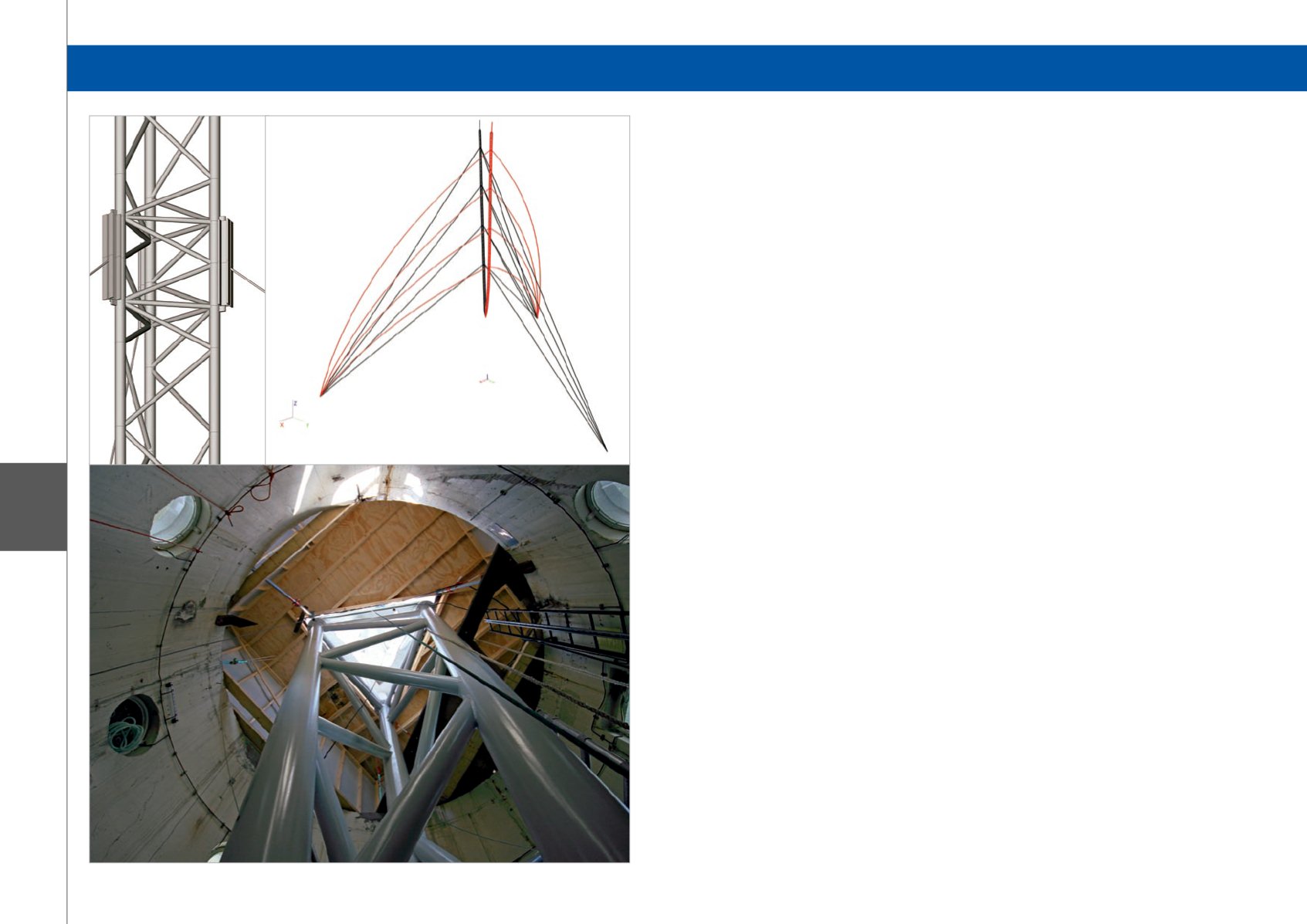
242
X4
Category 4: Special Projects
New Antenna Mast Smilde - Hoogersmilde,The Netherlands
The television and radio transmitter mast in Hoogersmilde
provides coverage in the northern part of the Netherlands.
After its failure in 2011 due to a blaze, Iv-Consult
contributed to the design process for the new mast using
Scia Engineer as FE software.
This project was carried out to a very tight schedule and
in close cooperation with client Omroepmasten B.V. and
contractor VolkerWessels Telecom, and together with
Iv-Bouw. This joint effort resulted in a new design and
appearance for the Hoogersmilde antenna mast.
Description of the structure
The original tubular section with a diameter of two metres
has been replaced in the new project by an open lattice
structure in a triangular section. The steel lattice mast is
built above the existing concrete tower, starting from the
level +80 m and reaching the height of 303 m.
The three CHS 244.5 x 25 vertical columns running from
the bottom to the top of the shaft are braced alternately
every 2,000 mm by diagonals CHS 114.3 x 5.0 lying in the
three sides of the shaft. The base of the mast consists of
a nine metre high pyramidal module aimed at conveying
the forces from the three vertical chords to the rocker
bearing at the top of the concrete tower. The lateral
support is provided by three groups of pre-tensioned
cables which connect, at four levels, the shaft to the
anchor blocks on the ground. Subdividing the plane in
three angles of 120°, the cables departing from each of
the three corners of the triangular section restrain the
shaft against the wind forces in every direction.
The erection of the mast was completed in two weeks
by a specialised helicopter installation company. Special
tools and procedures were designed by VolkerWessels
to ensure the success of the delicate operation, which
included the installation of more than fifty modules and
the guy wires that were flown into position and hooked up
in special devices. Feeder cables were finally installed to
provide transmitting signals to the antennas fixed to the
shaft. Ladders and platforms were installed for service
and maintenance purposes.
Design with Scia Engineer
Guy-wired masts are a relatively slender and fragile
type of structure since they only need to provide height
and resist wind. Nevertheless, guy-wired masts of this
scale are classified by code as one of the most complex
structures in structural engineering. Due to its national
importance, the mast was designed for consequence
class 3 in accordance with Eurocodes. This requirement,
together with the tight deadline of only a few months from
design to the start of the fabrication, made the analysis of
the structure a real challenge.
In order to allow for the high displacements of the
structure, a geometrically nonlinear analysis was
performed and Scia Engineer proved to be a useful tool
for this purpose.
The model consists of approximately 700 elements.
The “cable nonlinearity” and the “initial pre-stress”
functionalities offered by the software have been used to
accurately represent the behaviour of the guys. With the
use of specific modules, wind and ice loads have been
applied to all the guy wires and all structural members.
Wind, ice and permanent loads have been combined in
several nonlinear combinations and the governing results
were determined using the results classes. To control
and analyse the enormous amount of results, the “active
document” feature was used, allowing for an overview of
the results, updated whenever necessary.
The resistance and stability check of the members
composing the structure has been assessed by means
of a Scia Engineer module which incorporates the
provisions of EN1993-1-3.
The flexibility in the arrangement of the results as well
as the several exporting options were beneficial in
order to determine the effects related to the event of
a rupture of one of the guys. For this purpose multiple
analyses on different copies of the model were carried
out according to the “conservative procedure” and the
“simplified analytical model” (EN1993-3-1).
A modal analysis has moreover been executed to
determine the natural frequencies of the structure.
The software allows the user to easily transform the
applied loads in the correspondent mass attributes
which are used as input by the dynamic solver. With
the knowledge of the eigenmodes of the structure, its
sensibility to the wind frequencies can be evaluated.
Software: Scia Engineer


